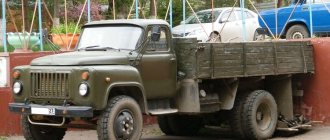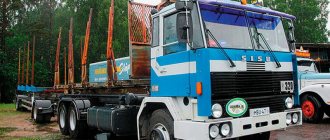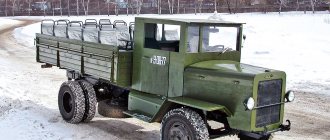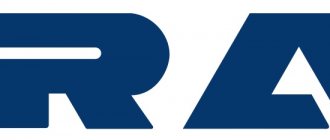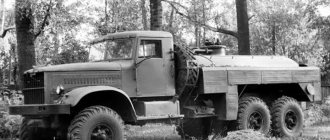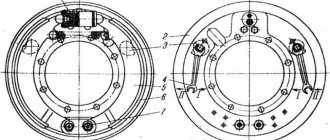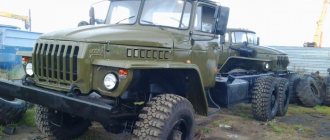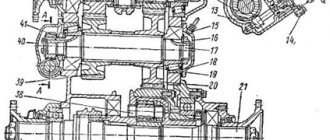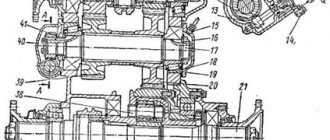Since its founding, the Ural Automobile Plant has specialized exclusively in the production of large equipment such as truck tractors or flatbed trucks. Moreover, most of the models assembled by the Urals are ready to overcome difficult off-road conditions. This is largely due to high ground clearance and efficient all-wheel drive.
- Media kit
- Advertising on the website
- Prices
- Contact
However, in the history of the USSR and Russia, there were cases when car factories producing similar equipment temporarily restructured their production process and retrained to assemble passenger cars. A striking example of this is KamAZ, which at a certain period introduced the ultra-compact Oka hatchback to the market. Moreover, even now the Kama Automobile Plant is taking part in the development of a project within which the budget electric car Kama-1 is being developed.
All this indicates that, if necessary, domestic companies can produce different types of cars. Therefore, it is not surprising that an independent designer created the concept of the new crossover Ural Next 2021-2022, publishing the corresponding rendering images. Moreover, despite the declared status, the presented SUV is fully consistent with modern trends in design thought. Externally, the Russian new product is similar to many other SUVs, but at the same time it has a number of distinctive features that set it apart from potential competitors.
Probably, the Volkswagen Tiguan could become a direct competitor to the presented crossover. This is supported by both the external similarities and the dimensions of the models. Also, the presented new product should receive all-wheel drive, without which it will be difficult for it to compete in the Russian market. However, if we consider that the Ural Plant produces only large vehicles, the question arises what type of platform will be used to create the new crossover. In this case, Renault can provide assistance to the Urals.
In a peaceful field
Ural Next - the future of the brand (all-auto.org)
Ural Next - the future of the brand (all-auto.org)
Developed to meet the requirements of the military, the Urals were also in demand in civilian life. Construction cranes, gas tankers, crew buses, snow plows - there are too many modifications based on them to name.
In 2005, Mexican Urals were actively used for humanitarian missions in New Orleans after the famous Hurricane Katrina - the abundance of flooded areas made the off-road qualities of these trucks irreplaceable.
Today the history of the Urals is not completed - the Miass residents are actively promoting the Ural-Next platform.
The harsh Russian “rogue”: the history of the Ural truck
URAL series
More than 200 types of special equipment are mounted on the chassis of Ural vehicles: crew buses, cranes, tank trucks, fuel tankers, fire trucks, repair shops, special equipment for the oil and gas and timber industry, mining and municipal services.
High maneuverability, large load capacity, reliability, and ease of maintenance have made Ural vehicles an indispensable equipment for various industries, agriculture and construction companies. The ability of Ural vehicles to move off-road is ensured by a powerful engine, a special design of drive axles, and a centralized tire air control system. Ural cars have high maintainability and are designed for garage-free storage. The Ural family of vehicles has a high degree of unification in terms of units and components, which reduces maintenance and operating costs.
The range of applications for Ural vehicles is very wide. Ural equipment is capable of operating at an altitude of up to 4500 m above sea level, at ambient temperatures from –50 to +50 ° C, capable of overcoming virgin snow up to 1 m, a ditch with a width of 0.6 to 1.2 m, a vertical wall height up to 0.55 m, height up to 31°, slope up to 20°, water obstacles up to 1.75 m deep.
One of the most important directions in the development of Ural brand equipment is the constant updating of its model range. In 2011, the company began serial production of all-wheel drive vehicles "Ural-6370" of the heavy class with a gross weight of up to 33.5 tons. The vehicles are produced in various modifications: dump truck, truck tractor, pipe hauler, etc. The Ural-6370 vehicle due to the use of modern components and units has reliability and service life indicators comparable to European brands. In 2011, mass production of the Ural-4320 family of all-wheel drive vehicles with a cabover configuration began. The main advantage of such vehicles is their increased installation capabilities. In the cabover version, chassis are produced for mounting special equipment, crew buses, truck tractors, and flatbed vehicles.
In 2014, serial production of the modernized Ural-M family of all-wheel drive vehicles began. While maintaining the traditional advantages of the legendary brand - unique maneuverability and high functionality, Ural-M trucks have increased reliability and comfort, improved handling and operational efficiency. The Ural M family, developed on the basis of the Ural-4320 serial chassis, includes a range of vehicles with 4x4 and 6x6 wheel arrangements in both traditional hooded and hoodless versions. About 50 changes and technological improvements were introduced into the design of Ural-M vehicles during development.
In 2015, the new generation car “Ural NEXT” was presented for the first time at an exhibition forum in Moscow. Modern appearance and interior, spacious and comfortable cabin, ease of operation, excellent ergonomics are achieved through the use of modern design solutions and components that meet international quality standards. In mid-July 2015, a test drive of Ural NEXT trucks was carried out, during which the vehicles demonstrated reliable driving characteristics and high performance characteristics. Production and sales started at the end of November 2015.
“Made with us” and on Yandex.Zen
War is the engine of progress. The history of the automobile once again convinces us of this. At the end of 1941, an enterprise producing spare parts for front-line trucks was opened in the small town of Miass in the Chelyabinsk region. It was created at the facilities of the Automobile Plant named after Ulyanovsk. Stalin, who had previously also been transferred there from Moscow. Workers installed equipment around the clock in the cold, and already in March 1942 the first workshop opened in Miass. Later it was decided that not only parts, but also the cars themselves would be produced here.
"Grad in the Urals"
The first three-ton ZIS-5V rolled off the assembly line in July 1944. Over the next year, the plant produced 6,800 vehicles, that is, more than 18 trucks every day.
In the post-war period, Ural satisfied the country's high needs for specialized vehicles. Dump trucks, garbage trucks, watering trucks and fire engines were produced on the basis of the ZIS-5M.
In 1958, the production of the ZIS-355M model began in Miass, which coincided with the development of virgin lands. The new vehicle was supplied mainly to Kazakhstan, Siberia and the Far East, where in off-road conditions and harsh climates it established itself as a reliable and unpretentious truck. Over 7 years, more than 190 thousand 355M were produced. During continuous operation of the enterprise, the production of one such machine took a little more than 20 minutes.
In the early 60s, the famous Ural-375, intended for transporting troops and cargo, was put into production. This vehicle is still used today as a chassis for the Grad multiple launch rocket systems. By the beginning of 1979, prototypes of the Ural-43201 appeared for use in the Far North. In 1981, the first batch of the Ural-5920 transporter was produced, which has high cross-country ability in difficult off-road conditions (swampy areas or snow debris). On February 21, 1986, it produced its millionth car.
In the turbulent 90s, the company experienced a difficult situation. The fatal six-year period 1992-1998. turned out to be the most unsuccessful in its history. If in 1991 31,371 cars were assembled, then in 1998 - only 2,489. Production fell catastrophically by 12.6 times. To survive, the plant had to master the production of non-core products: spare parts for cars, garden tools and even furniture. In 1998, he went through a painful bankruptcy procedure.
Returning all-terrain vehicles to service
A new page in the history of Ural began in 2001, when the enterprise became completely non-state and became part of the RusPromAvto machine-building holding. Prior to this, 1 billion rubles were invested in reconstruction and technical re-equipment. Since 2003, production began to grow at an average annual rate of 30%. In 2004, a new assembly system was introduced, thanks to which labor efficiency increased by 2 times and costs were reduced by three times.
In November 2005, a truck of a new road family rolled off the main conveyor - the Ural-63685 dump truck, designed for transporting crushed stone, sand and other embankments. The Ural-63674 truck tractor was also produced - a vehicle for long-distance drivers, capable of towing a semi-trailer weighing up to 34.5 tons. It was recognized as the best truck in one of the categories at the Moscow International Motor Show 2006.
In the mid-2000s, special shift buses were designed and manufactured at Ural at the request of the oil industry, and a series of armored vehicles were designed and manufactured for the Ministry of Defense.
In 2008, total output increased to 15,158 units, with the share of export deliveries amounting to about 10%, but the global financial crisis crippled the work of the enterprise. In 2009, production fell again, of course, not as catastrophically as 11 years ago, but also noticeably - to 6,334 cars. However, already next year, thanks to the support of the federal government, the situation was significantly improved. In 2010, the plant produced 9.4 thousand cars, and in 2011 – already 11.7 thousand.
Currently, 13.8 thousand people work at Ural. The territory of the enterprise is more than 300 hectares, which is 48 times larger than the area of all the exhibition halls of the State Hermitage. Ural brand vehicles are in service with the armies of 40 countries. High cross-country ability, reliability and ease of maintenance have made Miass trucks indispensable equipment in difficult to navigate areas. Among the main customers of the plant are large oil and gas producing companies, construction organizations, the Ministry of Defense, the Ministry of Internal Affairs and the Ministry of Emergency Situations.
1.
2.
3.
4.
5.
6.
7.
8.
9.
10.
11.
12.
13.
14.
15.
16.
17.
18.
19.
20.
21.
22.
23.
24.
25.
26.
27.
28.
29.
30.
31.
32.
33.
34.
35.
36.
37.
38.
39.
40.
41.
42.
43.
VIDEO ABOUT THE ENTERPRISE:
https://zavodfoto.livejournal.com/1330264.html
Do you remember how it all began…
Construction of the plant in the city of Miass, Chelyabinsk region, began in 1939. According to the plan, it was not an automobile plant, but a military ball bearing plant No. 316. It was the production of bearing products that was planned to be launched at the Miass plant.
The site for its construction was chosen back in 1936. Specialists from the design institute from Leningrad (now St. Petersburg) determined the construction site and developed technical documentation. Preparation of the territory for the construction of workshops began, and a railway line was laid.
Instead of ball bearings - engines and cars
The Great Patriotic War confused all plans. On October 16, 1941, the evacuation of the Moscow Automobile Plant named after Stalin - ZiS was announced. Three days after the decision was made, a convoy with machines, equipment and employees set off for the Volga, to Ulyanovsk.
However, the situation at the fronts was so difficult that just a month and a half later, on November 30, 1941, the State Defense Committee decided to relocate engine production to the Urals. In Miass they decided to organize automobile engine and foundry production. And the site already prepared for the construction of plant 316 made it possible to carry out this logistics operation in the shortest possible time. It was November 30, 1941 that became the official birthday of the new Ural automobile plant.
Record production launch times
It is worth noting that martial law obliged to speed up the process. Despite the winter frosts, equipment installation was carried out around the clock. There was a catastrophic shortage of building materials, so workers removed the machines and installed them right in the open air.
Simultaneously with the installation of equipment, production buildings were erected. In March 1942, i.e. just three months later, the first workshop of the Miass Automotive Plant began operating. Already in April, the first gearboxes and engines began to roll off the assembly line. The task of the State Defense Committee to establish the production of components for ZiS vehicles was completed in four months - a record time even by modern standards.
Already in 1944, the Urals modernized the engine. The shape of the intake fuel pipes is changed, a new MZK-6V carburetor is installed, but most importantly the compression ratio is increased to 5.3:1. Thanks to this, engine power increases to 76 hp.
The birth of Zakhara - the first truck of the Ural Automobile Plant
However, in addition to engines, the front was sorely lacking in vehicles. Therefore, in mid-February 1943, a decision was made to modernize production in Miass for the full production of trucks.
The first ZIS 5V truck with a carrying capacity of 3 tons rolled off the assembly line of the still unfinished workshop on July 8, 1944. By the end of September, the Ural Automobile Plant had already produced 1,000 vehicles, and by the end of the year, 3,000 three-ton UralZIS trucks were shipped to the front and for household needs.
Of course, wartime vehicles were structurally different from ordinary trucks. Both the lack of materials and the lack of equipment had an impact. The ZiS 5V cabin was made of wood, the front wings were simply bent from any iron, and only the tailgate was hinged. As for the brakes, they were completely absent in front. Braking was carried out only by the rear wheels.
But this is exactly what was needed at that time. The simplicity and reliability of the Ural vehicles resonated with the soldiers. Front-line soldiers called ZiS 5 Zakhar or, affectionately, Zakharka. The famous Katyushas were mounted on them, and from their very birth, Ural cars helped the army forge the Great Victory.
Post-war development of UralZIS
After the war, the automobile plant remained in Miass. Fuel problems are forcing design engineers to come up with solutions to convert trucks to alternative energy sources.
The Central Scientific Research Institute of Mechanization and Energy of the USSR (TSNIIME) is working on the issue of converting machines to gas installations. Gas generators TsNIIME-16, operating on charcoal gas, are being designed. A little later it is modernized and the Ural ZIS 332 appears. Despite the drop in power and load capacity, the truck successfully passes tests.
Along the way, work was carried out to improve cars. The trucks received a shoe parking brake, a driveshaft on needle bearings, a forced engine, a heater and a cabin fan. The new vehicle had a payload capacity of 3.5 tons and received a new cabin.
UralZIS-353 - this is the designation the car received - had a cabin and wings in shape close to the GAZ-51. This was explained by the fact that the Miass enterprise did not have press and stamping equipment at that time and was forced to use duplicate dies from the Gorky Automobile Plant.
The 353rd model did not become a serial truck. The UralZIS 355M was put into production in 1957, which was initially intended to be used for work in virgin lands. At the same time, the automobile plant in Miass produced the first all-wheel drive truck, the UralZIS 381. Interestingly, the transfer case and front axle on it were borrowed from GAZ.
And in 1965, the production of two-axle trucks was stopped in Miass. Three years earlier, the plant lost the “name of Stalin” in its name and UralZiS was renamed the Ural Automobile Plant - UralAZ.
Specifications
Questions arise regarding the technical equipment that the new Ural crossover may receive. The most likely solution to this problem will be to transfer this model to the CMF-B-LS platform, which Renault is already implementing in Lada cars. This assumption is partly supported by the fact that the French company in Russia does not have a crossover that could compete with the presented new product. That is, it will be profitable for Renault to expand its model range and enter a fairly popular segment of the domestic market.
If the assumption made turns out to be correct, then technically the new product presented will be identical to Arkana. The crossover will receive a 1.33-liter turbocharged engine, which can also be found on the Mercedes-Benz GLB. The maximum output of this unit will not exceed 150 hp. All-wheel drive will also be transferred from Arkana to the presented new product. By the way, the conceptual crossover Ural-4320 2021-2022 may have similar characteristics.
Design
In the presented new product from the Urals you can find many details that make it similar to other SUVs, as well as to the recently presented conceptual crossover Ural-4320 2021-2022. However, this similarity is mainly due to the modern approach applied to the development of such models. That is, we can say that the presented cross fully meets the demands of the world market. But he is ready to offer a number of interesting solutions that will attract buyers.
READ ALSO: Rendering images of the Haval H9 2022 SUV have been published
One of the important features is the configuration of the front end of the body. Its support pillars are strongly tilted back, and the hood, which has 2 pronounced stampings, gradually bends downwards. Both design solutions are typical for both sports crossovers and electric SUVs. This configuration not only improves the appearance of the car, but also increases the aerodynamic drag coefficient. That is, the new Ural crossover simultaneously provides good fuel efficiency and excellent dynamic characteristics.
Read us:
The second important detail of the presented model is also located in the front part of the body. Here the developer has placed non-standard head optics, presented in the form of two long horizontal strips with LED lights, which come from the wheel fenders and pass without breaks under the edge of the hood. At the front, another detail attracts attention: these LED strips intersect thin transparent plastic, behind which the direction indicators and additional lights are probably hidden.
The third interesting feature is that the presented new product is equipped with a large trapezoidal radiator grille, which runs from the edge of the hood and almost to the very bottom of the bumper. Its internal filling consists of thin vertical stripes, which, slightly bending forward, thus form a zone under the brand name. On the sides of the radiator grille, the developer made large cutouts intended for pentagonal ventilation holes, along the edges of which additional LED strips are laid. Note that a similar design of the bow is also present in the Ural-4320 2021-2022 crossover, which combines the concepts into one line.
At the bottom of the front bumper there is a fairly long air intake, framed on the sides by a kind of “skirt” obtained thanks to the original bend of the plastic. Closer to the wheel arches, there are niches in which fog lights will likely be built in. The appearance of the front part of the body is completed by a thin plastic body kit attached to the bottom of the bumper. It is also laid along the wide wheel arches and side doors.
The profile part of the presented new product is designed in strict accordance with the style characteristic of mid-size crossovers: the same even proportions, sharp folds and an almost straight roof, ending near the wing protruding back.
READ ALSO: The completely new UAZ Patriot 2021 pickup truck has been declassified: unchanged practicality in a completely different design
The stern of the Ural Next 2021-2022 crossover is distinguished by its relief outlines. The car received a fairly large glazing, under which there is a rounded protrusion, highlighting an area under the name of the Russian brand. Adjacent to this part of the stern are large taillights with C-shaped sidewalls extending onto the rear wheel fenders. An original strip extends down from the stern optics, which gradually becomes rounded as it approaches the bottom. Thanks to this exterior detail, the area intended for placing the license plate is visually highlighted.
The appearance of the Russian novelty is completed by a rear bumper that is non-standard for such crossovers. Curving black plastic stretches along it, forming a kind of canopy over a mesh grille simulating a diffuser. Additional protection is also located in this area.
